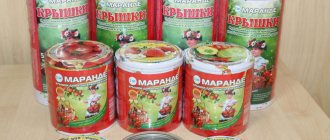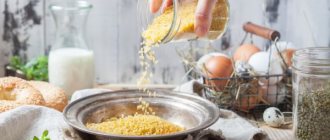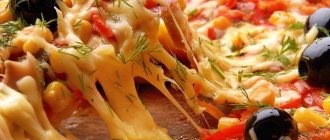The history of blue cheeses
Little is known about the history of the product. Everything is based mainly on a legend.
A young shepherd grazed sheep in alpine meadows in the provinces of Italy. His mother gave him a piece of sheep's cheese and bread for lunch. At the time of the meal, the young man saw his beloved and interrupted the meal. What happened next in the love story is not known, but the shepherd returned to the cave where he started having lunch after 3 months.
The cheese just lay there. The young man was very hungry. He was not bothered by the mold that had formed on the food. Having tasted a piece, he realized that he had never eaten anything tastier in his life. He told the villagers about his discovery. Cheesemakers began to leave the product in caves in order to achieve the ideal taste.
Mention of modern cheese with noble mold was recorded back in 1070. Although in ancient times they knew about this delicacy.
In the modern food industry, cheese is produced in a more humane and, most importantly, faster way. The process takes place in laboratory conditions. Special holes are made in the head. This helps the mold that is placed on the cheese to spread better.
The delicacy is produced in almost all countries.
Popular varieties
Each of the existing types of delicacies, covered on all sides with white mold, has its own homeland, its own history of origin and distribution. Such dairy products are becoming increasingly popular - true connoisseurs, gourmets and ordinary consumers value them for their aromatic properties and excellent original taste. The most famous varieties are:
- brie;
- boulet d'Aven;
- Neuchatel;
- Crotten;
- Camembert;
- Saint Maur;
- Valence.
Brie - soft cheese with noble mold made from cow's milk
The French delicacy gained unprecedented popularity several centuries ago. The product is made from fresh unpasteurized cow's milk using rennet, and after 2 hours it is placed in molds. The curd is left unloaded for a day, then removed and salted. Brie is left to mature for 2-4 weeks. The product matures due to the activity of mold enzymes penetrating inside. The consistency of mature cheese ranges from semi-liquid to waxy.
The classic French delicacy attracts consumers not only with its creamy pulp, but also with its delicate creamy-nutty taste (with a barely noticeable bitterness), intertwined with mushroom and fruit notes. Young soft cheese with white mold has a sweetish taste, while mature cheese has a sharp and bright aroma. There are several varieties of this variety:
- Brie de Meaux is covered with a thin crust, under which there is a yellowish, buttery, practically non-spreading creamy pulp. It has a rich aroma and a well-defined sweetish-nutty flavor.
- Brie de Melun - with a dense yellow center, a bright aroma with notes of mold, hay and damp earth. Captivates consumers with its refreshing, strong taste.
- Brie Noir, unlike other varieties of the subgroup, has richer flavor notes, a pronounced aroma and a long aftertaste, because it reaches full readiness within a year, while the cheese is provided with special conditions. Brie Noir is covered with a gray-black crust, which is slightly peeled off with the blunt side of a knife before use.
Boulette d'Aven – French flavored cheese with seasonings
The dairy product is made using cow's milk. The name of the delicacy comes from the city where its history began - Avena. When preparing boulette d'Avena, the base was first based on low-fat cream made from cow's milk. Later, manufacturers changed the recipe, and used fresh sediment obtained from Merual cheese as the main ingredient.
Boulette d'Avena is prepared as follows: the mass is crushed, mixed with various seasonings (cloves, parsley, tarragon, pepper), and shaped into cones or balls. The crust is tinted with annatto, a special plant, and then sprinkled with paprika and mold. To ripen, the cheese is left for 2-3 months. During this time, the crust is periodically soaked in beer, which makes it more aromatic and tasty.
The cheese has a round or original triangular (cone-shaped) shape, the weight of one product does not exceed 300 g. The surface of boulette d'Avena is covered with a moist red crust consisting of mold and paprika. Inside lies snow-white pulp with aromatic spices. The fat content is 45%, and the main flavor notes of the delicacy are provided by pepper, tarragon and the main dairy component. The French delicacy is used as a main course or served as an appetizer.
Camembert is a plush cheese originally from Normandy.
Camembert de Normandie is a product made from cow's milk. According to legend, the recipe was discovered by a peasant woman from the village of Camembert in 1791. Camembert is one of the most popular types of soft cheeses. In hot weather, the production of this dairy product is often difficult, so it is produced from September to May. Favorable conditions contribute to the accelerated growth of white plaque, which quickly turns blue, so the surface of the product becomes covered with a bluish-gray crust.
After this, the product is transferred to another basement, where the humidity level is maximum and the air temperature is about 10 °C. Under such conditions, microorganisms grow more slowly and become reddish-brown. Cheese is considered ripe when its consistency is viscous. The finished dairy product should be soft to the touch, but not crumble when cut. A hard middle and semi-liquid pulp around indicate that the product was prepared without following the technology.
A high-quality Camembert is covered with a white velvet crust, and the “wrinkles” should have a pink-red tint. The smell is fresh, there may be mushroom notes. The product has a delicate creamy taste and does not smell of ammonia under any circumstances. The heads are packed in straw, 6 pieces each, and transported in light wooden boxes. Camembert does not last long, so it is often sold unripe. In this case, you will need to let the cheese ripen at home without cutting the white surface. Before use, remove the product from the refrigerator, cut into portions and leave to melt slightly.
- Measles in adults - signs and symptoms of the disease, photo
- Osteopath - who is it and what does it do? Reviews about treatment by an osteopath
- Depilation of the intimate area - with cream, wax or sugar. How to depilate the intimate area at home
Buche de Chevre - an exquisitely piquant cheese in the form of a roll
This dairy product is produced in Russia using French technology. The main ingredients are milk from exotic Nubian goats and Spanish noble mold. The product is produced in the form of a large roll, the surface of which is evenly covered with a thick layer of snow-white crust. Buche de Chevre has a delicately pungent taste, while nutty notes are noticeable near the velvet shell, and closer to the middle there is a creamy taste and aroma.
Neuchatel is a delicacy with a hard, heart-shaped crust.
This French blue cheese is produced in Upper Normandy. The peculiarity of Neuchatel is its dry, dense crust with a snow-white fluffy coating and elastic flesh with a mushroom smell. The technology for making the product has remained virtually unchanged for several centuries: milk is poured into warm containers, rennet and whey are added, after which the mixture is left for a couple of days. The whey is drained, bacteria are sent into the dishes, then the mass is pressed and dried on wooden shelves. Neuchatel is salted by hand and then left in the basement to mature for 7-10 days.
The fat content of the finished French dairy delicacy is 50%. The product has a dry, velvety crust, the surface of which is completely covered with uniform snow-white noble mold. Neuchatel differs from other types of cheeses in its original shape - it is mainly prepared and served in the shape of a small or large heart, rather than the traditional circle, oval or square.
Composition and calorie content
The chemical composition of blue cheeses is quite rich. It is saturated with the following components:
- amino acids (replaceable and essential);
- microelements;
- macroelements;
- fatty acids of varying saturation;
- sterol;
- numerous vitamins (A, group B, D, E, PP, retinol, phylloquinone).
A varied chemical set makes the product high in calories. For example:
- white mold cheese contains from 227 kcal (Shaurs) to 427 kcal (Cambozola);
- delicacy with red mold - 340 kcal;
- product with blue additives - from 330 kcal (Gorgonzola) to 369 kcal (Roquefort).
Questions and answers
Is it possible to eat white mold on cheese?
Yes, if it is noble mold, beneficial for the body, and not a poisonous coating.
What are the benefits of Dor Blue blue cheese?
This cheese has more carbohydrates than other varieties and helps increase energy in the body.
How many calories are in blue cheese?
The calorie content of blue cheese can vary: on average it is 353 kcal.
Can blue cheese go bad?
Yes, if you do not adhere to the requirements regarding the terms and conditions of storage of this product. Moreover, the appearance of natural mold may not be visible to the naked eye, so it is better to focus on the date on the packaging.
There is mold on the cheese, is it safe to eat?
If it has not spread to the inside of the product, you can carefully cut off the plaque and eat the cheese.
Is it possible to freeze blue cheese?
Only the Brie cheese variety can withstand low temperatures; other varieties will lose their beneficial properties in the cold.
Can a nursing mother eat blue cheese while breastfeeding?
Can children eat blue cheese?
The body of a young child is more susceptible to infections, and the components contained in mold will affect him more than adults. Therefore, it is better to refrain from adding this product to the children's diet.
If you consume blue cheese correctly, you will not experience unforeseen consequences, and your body will become stronger and more resistant to diseases - all you have to do is choose your preferred variety.
A small but interesting video from Russia-1 channel about blue cheese: you will learn how it is prepared, what is the benefit and harm of the product for the human body:
We all know that mold is bad. That if you eat a green bun or sausage with a smell, you can end up with serious poisoning, and anything that smells sour should be immediately thrown into the trash.
And yet, many do not disdain either smelly sausage, or loaves with green spots, or even sour sour cream. And they are alive and even healthy! Why? The point is not that some people have poisonous mold growing in their refrigerator, while others have edible “noble” mold. It’s just that some products can actually be saved even if there are signs of “mouldiness”; others, on the contrary, should under no circumstances be consumed, even after cutting off the mold.
How to distinguish one from another and how exactly to save food from mold? Here are some recommendations given by the American Food Safety Inspection Service (FSIS).
It is worth noting that the mold added to such cheeses differs from the standard one, which is formed when the product’s shelf life is violated. Therefore, you can have no doubt about the benefits of cheeses with white mold for the body.
Types and varieties
There are a huge number of moldy cheeses all over the world. The general manufacturing method is the same, but the output is products of various types and varieties.
Blue cheese (blue cheese)
There are many varieties of products with blue mold. The most popular of them:
- Roquefort. The variety is the most expensive. The taste is piquant, quite spicy. The basis was sheep's milk and rye bread. Mold (penicillium roqueforti) is obtained from the second ingredient. Perfection is achieved not in a laboratory, but in a lime cave. Sometimes you have to artificially obtain low temperatures and high humidity.
- Gorgonzola. Price range varies. It all depends on the exposure time. The taste is a little sweet. Made from cow's milk (like all the others). The product also ripens in caves, but this is not the main feature. Cheese that is ready to eat is wrapped in foil.
- Dor blue. It gained popularity for its soft, delicate taste. The main production is located in Germany. The recipe is kept secret, although it was discovered in the last century. It is in high demand in the Russian Federation.
- Danablu. The taste is salty. During consumption, you can detect notes of spiciness. The manufacturing process takes place exclusively in industrial conditions. Roquefort lovers will appreciate it. Danablu is its complete analogue. They just bring it to perfect condition in the cellar.
- Stilton. Has a bright taste. Even those who don't like cheese will appreciate it. The base is pasteurized cow's milk and sourdough. To achieve the ideal color of mold and its uniform distribution as quickly as possible, a head of cheese is pierced with special steel needles.
White mold cheese (penicillium candidum)
This is the type of cheese that can most often be found on the shelves of regular supermarkets. The most popular varieties:
- Bree. There is another name: “Cheese of Kings”. The delicacy comes from France. Its main differences are the softness of the product itself, its spicy and memorable taste. It is not large in size. In stores, the maximum weight of one piece is 100–150 grams.
- Camembert. It is based on cow's milk. Only amateurs appreciate it. It is difficult for ordinary people to accept its ammonia smell and musty mushroom taste. Camembert has a short shelf life. This is the reason that it is often sold unripe.
- Boulette d'Aven. Although the cheese is a type with white mold, sometimes it has a red crust. It has one of the most pungent smells of all French cheeses.
- Cambozola. Only premium quality milk is used in production. No additives or spices. The finished product contains both blue mold and white mold. The first one is inside. It is introduced using needles. The taste is a little spicy. The consistency is delicate.
- Kare. There is an edible moldy crust on top of the product. In all respects he is similar to Brie.
- Coulommier. It belongs to the group of soft French cheeses. Often, on the surface, along with white mold, you can find red blotches. For Coulommier this is the norm. Ripening period is 2 months. If the cheese is not cured, the density will be unsatisfactory.
- Neuchatel. Soft cheese. The mold is on top of the head. It is airy (reminiscent of meringue). The main highlight of the variety is its shape. The manufacturer himself decides in what variation to release the finished product. There are 6 shapes in total, but most often on store shelves they are presented in the shape of a heart.
- Pont-Leveque. Cheese with a brightly grown aroma. The reason is prolonged exposure to brine. There is a home and factory product. The first one is sold only in Normandy.
- Rouzette. Has a cap of white mold. This type of cheese is classified as pickled cheese. The plaque is washed off about 5 times during the entire preparation and maturation period. Contains paprika. The crust may have pink tints.
- Shawrs. The texture is creamy, but it is not classified as a soft variety. You can recognize it by the taste of mushrooms or hazelnuts. The shape of the cheese head is square and small in size.
Red mold cheese
There are few such cheeses. Samples are represented by varieties:
- Livaro. This cheese is not recommended to be cooked during frosts. The finished product has a brown tint. It is best to purchase cheese that has been aged for at least 6 months.
- Epoisse. The main characteristics are a sharp smell and at the same time delicate taste. Sometimes you can feel notes of cream. The cheese ripens in specialized rooms on wooden shelves. After red mold has appeared, the head is treated with a solution of salt and vodka. This helps prevent the proliferation of microorganisms in the product.
- Maroy. A variety that takes relatively little time to prepare. You can eat it one month from the date of production. There is only mold inside. During the ripening process, the heads are washed thoroughly so that there is no fungal coating on the surface.
- Reblochon. The preparation process involves 3 types of milk from different breeds of cows. After pressing, the cheese is washed. The taste may resemble fruit and sometimes nuts.
- Munster. To achieve a red tint, the cheese is poured with salt solution. The product reaches perfection in the cellar. It is important to have old samples of the product nearby.
Cheese with green mold
Cheeses with a green tint are few and far between. The most popular varieties:
- Stilton. It can be prepared only from the freshest cream from homemade cow's milk. The taste is spicy, the aroma is pleasant.
- Bergader. Basically, mold is found only on the surface. Sometimes green veins may appear. The taste is sweet.
- Sainte-Agur. It has only one shape - an octagon. The texture is creamy, the taste is spicy. The variety contains a high percentage of fat.
Recommendations for use
The product is best eaten in the evening , since calcium is absorbed by the body at night.
The optimal amount is 30 g , but not more than 50 g for daily use. Traditionally, all elite varieties can be eaten with bread, but without butter. The exception is Roquefort.
White mold cheeses such as Brie or Camembert go well with soft white bread, and blue varieties are usually eaten with crispbread.
All products go well with fruit, especially pears and grapes. The best friends of these aristocrats are dry and semi-dry wines.
Dry red wine is served with white mold cheeses. The piquant, pungent taste of blue mold cheeses is perfectly emphasized by white semi-dry wines.
Read on our website all about the beneficial properties of kumiss, and why nutritionists recommend this healing drink to those who want to lose weight!
In the next article we will talk about the benefits of chicken eggs for the body of men, women and children, and whether there are any contraindications for this product.
A few facts about the medicinal properties of quail eggs, useful recipes with a dietary product can be found here: https://foodexpert.pro/produkty/zhivotnovodstvo/rerepelinyie-yaytsa.html.
Use in cooking Brie, Roquefort, Dor Blue and other varieties
Blue cheese is served at the end of dinner or late lunch, as an independent dish or as part of a cheese plate. Spicy varieties are used in preparing spaghetti sauces. The product with blue mold can be grated and sprinkled on vegetable salad.
Making sandwiches is common. For example:
- Grind Roquefort with butter , spread on warm white toast, cutting off the crusts first.
- Mix brie with Dijon mustard. You can spread this mixture on thin Armenian lavash, roll it into a tube and leave it in the refrigerator for a day. Then cut diagonally. Serve with grape juice or any dry wine.
- Cut the Conference pear into slices, put a piece of Dor Blue on top of each.
All products go well with thin dessert pancakes and black coffee.
From this video you will learn a recipe for preparing a delicious and light salad from the chef using blue cheese:
Use for weight loss
Mold aristocrats do not promote weight loss, but they can be included twice a week in any low-calorie diet.
These products give an unforgettable taste sensation , a good mood, and quickly create a feeling of satiety.
For those wishing to lose weight, these cheeses are useful with fruits and vegetables. This combination will allow all beneficial substances to be fully absorbed without gaining excess weight.
When purchasing elite blue cheese, take care of its proper storage. To do this, it is advisable to purchase a special cheesecake, which along with the product should be kept in the refrigerator at a temperature of 5-7 degrees.
Can pregnant women and children eat blue cheese?
Women who are in an interesting position should refrain from eating blue cheese. There is a risk of contracting listeria (the appearance of bacteria in the body that cause intestinal diseases).
Infection can lead to serious consequences: fetal death in the womb, miscarriage. Even if the pregnancy went well, there is a chance that the child will be born with a disorder of the nervous system.
Pediatricians also advise mothers not to include blue cheese in the diet of their children (at least until they are 1 year old). The baby's stomach cannot always digest a complex dairy product.
Children suffering from gastrointestinal disorders should not eat blue cheese until they are 3–4 years old.
Potential dangers and contraindications
The main danger of mold cheeses is individual intolerance to penicillin and infection with listeria with low immunity. You should also not eat cheese if you have the following diseases:
- fungal, including thrush;
- arthritis, polyarthritis;
- asthma, neurodermatitis.
You should use the product very carefully if you are obese or prone to swelling due to high salt content, especially in varieties with blue mold.
You can learn a few more interesting facts about the benefits and potential harms of blue and white mold cheese from the following video:
Beneficial features
Eating blue cheeses has a beneficial effect on the internal organs of the human body performing their functions. Positive results from including the product in the diet:
- consistently good functioning of the gastrointestinal tract;
- fast and effective production of hormones;
- stimulation of wound healing;
- nutrition of the body with phosphorus and milk proteins;
- memory improvement;
- increasing immunity;
- fight arthritis and cellulite;
- restoration of heart rhythm;
- strengthening tooth enamel;
- reduction of various types of inflammation.
The result becomes noticeable if you consume blue cheese daily, but not more than 30 grams for medicinal purposes and 50 grams to saturate the body during hunger.
How to define quality?
Blue cheese is a very common and in demand product. In order not to be deceived by sellers, you should familiarize yourself with tips for choosing a quality delicacy:
- a piece of cheese should not have oil on the surface (its presence means that palm oil was added during the cooking process, which has a detrimental effect on human health);
- the composition should not contain anything other than milk, salt, penicillin and starter culture;
- cheese belonging to the brine varieties should not disintegrate when squeezed;
- the presence of the smell of penicillin, the presence of a crust and traces of a lattice indicate good quality cheese;
- the maximum shelf life is 2 months (if the cheese can be stored for longer than the specified period, this indicates the addition of preservatives);
- many holes indicate low quality;
- good cheese comes wrapped in wax paper.











